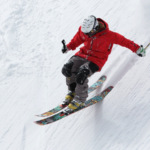
Going up the mountain with a kite!Jane Dunbar Summer and winter. For a while, these seasons dictated what Tim Stockman would do: kitesurfing at the beach in summer, and snowboarding in the mountains in winter.
Article continues After Video….
Thoughts?
Going up the mountain with a kite~ ~Snowkiting

Going up the mountain with a kite!
Jane Dunbar
Summer and winter. For a while, these seasons dictated what Tim Stockman would do: kitesurfing at the beach in summer, and snowboarding in the mountains in winter.
Article continues After Video….
Thoughts?
Then he discovered he could combine the power of a kite with a snowboard, and a love of snowkiting took off.
Once hooked, he and his friends went searching for good spots to kite.
“In the early days, when there was a good snow season and we got snow low around Canterbury we’d go kiting anywhere we could grab it.
If there was a breath of wind all we needed was snow on the ground. Parks, farm fields, the Port Hills, I’ve even kited on the beach in New Brighton on my snowboard when it was snow covered. But once you’ve had a crack at it, you want better terrain and cleaner wind, that’s why we head south. It’s epic!”
The Queenstown and Wanaka regions are world-class for kiting, he says.
Stockman loves “the space and freedom, the endless untracked powder and the massive distances we can cover fast under the power of a kite”.
“It’s like cross-country or back-country skiing but on steroids. We use the kites to pull us up hills too, then park the kite at the edge of the wind and ride the powder down or boost (jump) off a hill. Whatever takes your fancy really.”

More on Snow Kiting…
Wind, of course, is the key ingredient.
“I can kite up a hill in as little as 5 knots or about a 9kmh breeze. This is OK, but stronger winds of 10-15 knots are really fun, 20 knots epic, 25-30 knots full-on but exhilarating, 30-40 insane but doable by only a few.
“If the wind is moderate it usually holds up for the day, if it’s light it can die off, which means you may have a hike out. The rule is ‘only kite as far as you’re prepared to walk out’. But there are plenty of kiters who skin on skis or split boards, or if you have one, a snowmobile for access and quick exit.”

To snowkite, you use a waist harness that hooks into a kite, which can range in size from 4m square to 14m.
“The kite is controlled on a bar, and you steer it like a bicycle – pull left, the kite steers left, pull the right, it steers right. You can push the bar away, too, this de-powers the kite. The power control is quite amazing. We can handle huge gusts with ease.”
How safe is it?
“We kite low-aspect terrain, so generally the conditions are pretty safe. We do push the sport, though, and sometimes we head into steeper terrain with dramatic features that could be quite dangerous for the inexperienced.
“This type of kiting deserves respect. There’s a good crew of kiters in Christchurch and down south who have the skills to handle themselves, and even in strong winds the kites are very manageable. The sport is all about good management of yourself and equipment and knowing when to turn around and head home.”
Snowkiting started to take off in New Zealand soon after the start of kitesurfing, around 2000.
“Worldwide it’s following on the huge kitesurfing wave.”
Snowkiting is a bit easier to learn, but logistically it’s harder to access the wind and snow.
In Stockman’s view, the best place to try snowkiting is Snow Farm in Wanaka because of the ease of access and because the wind is usually good.
Snowkiting is a great way to master kite and board skills, and you’re then in a good position to learn kitesurfing in the summer, he says.
“The idea is to get a controllable kite in your hands whether on the beach, park or mountain and get out and fly it, no matter what the season.”


















